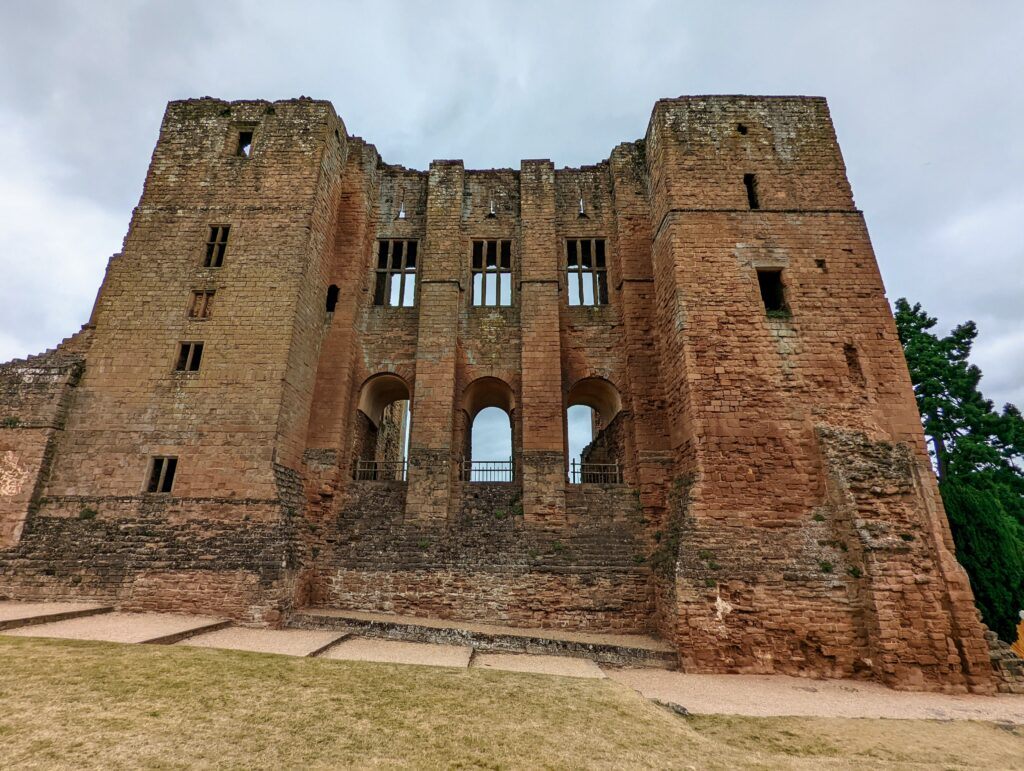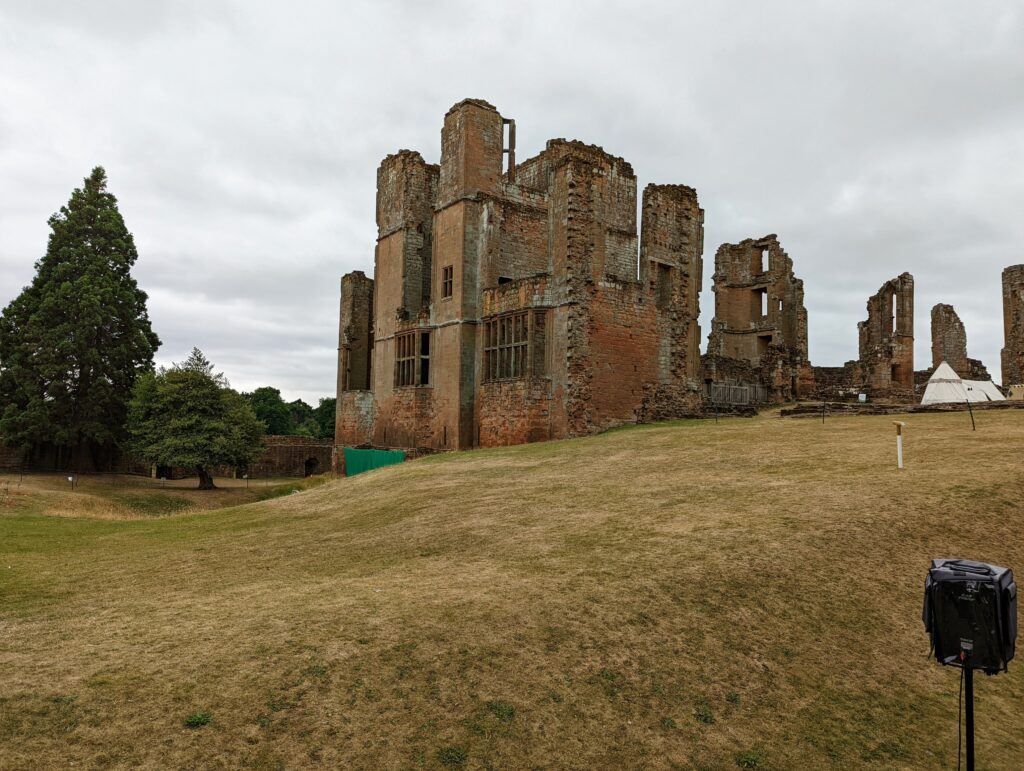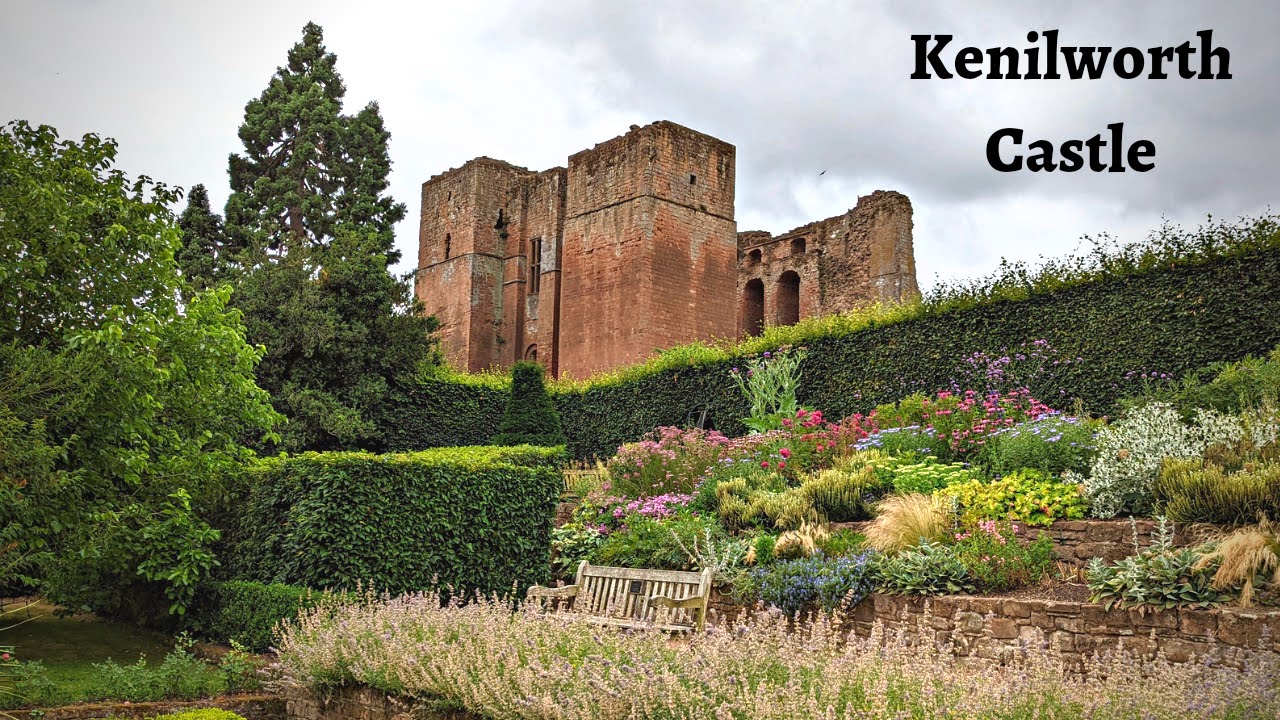Kenilworth Castle is located in the town of Kenilworth in Warwickshire and dates back to the 12th century. It was first founded by Geoffrey De Clinton and developed and extended numerous times. The castle’s history goes back a long way and includes many royal and other significant historical figures. Kenilworth was the subject of a six month long siege in 1266, which is considered to be the longest siege in Medieval England. During the War of the Roses it was a key base for the Lancastrians and has been the scene of many important historical events.
| Built | 12th Century |
| Type | Motte-and-Bailey (replaced by a fortified keep and curtain wall) |
| Condition | Ruinous (Major stone works remain) |
| Ownership | English Heritage look after the estate |
| Access | Public (on certain days) – Admission Fee |
Click here to watch our tour of Kenilworth Castle and discover it’s history
The De Clintons
The first castle built at Kenilworth was by Geoffrey De Clinton in the 1120’s, Geoffrey was Lord Chamberlain and treasurer to Henry I and was later made Sheriff in Warwickshire. The original castle consisted of an earth motte with timber buildings.
At the time of the Great Revolt (1173-74), Kenilworth was garrisoned by Henry II’s forces. Around this period Geoffrey II De Clinton died and the castle was taken into royal control. The castle is thought to have consisted of at least a great tower (later incorporated into Mortimer’s Tower), the stone walls of the inner bailey and a lake with a basic causeway.


Royal Castle
Over the following 70 years the castle’s fortifications were vastly extended as Kenilworth was seen to be a strategically very important fortification.
King John spent a vast amount for the time, about £1,100 on Kenilworth between 1210 and 1215 during his campaign to strengthen royal castles following his excommunication by the Pope in 1208. King John heightened the dam to enlarge the lake and create the mere. Substantial improvements were also made to the great tower and other defences including Lunn’s and Mortimer’s Tower and the outer bailey were built in stone. Kenilworth Castle was transformed into one of the largest English castles of its day.
Despite all of King John’s efforts he was still forced to sign the Magna Carta in 1215.
De Montfort Era
Following King John’s death in 1216, his young son Henry III was crowned king. In 1244 Simon De Montford was given custody of Kenilworth Castle for life after his marriage to Henry III’s sister Eleanor in 1238 and in 1239 he was made Earl of Leiceseter.
Times changed though and Simon switched sides and was now against the king and Simon became the leader in the Second Barons’ War (1263-67) against Henry III. Following his defeat at Battle of Lewes, Henry III was forced to sign Mise of Lewes and give his son, Prince Edward to the rebels as hostage. Edward was held at Kenilworth Castle in harsh conditions but released in 1265.
Edward and his royalist forces then went on to defeat and kill Simon De Montfort at the battle of Evesham on 4th August 1265.
The Great Siege
Following Simon De Montford’s defeat and death, his eldest son Simon the younger promised to surrender Kenilworth to the crown, but his fathers supporters refused. When Henry III sent a messenger to collect Kenilworth Castle’s keys as promised, rather than hand the keys over they chopped off the messenger’s hand. Henry III was outraged and on 21st June 1266 an all-out siege began.
Kenilworth’s water defences prevented the undermining of the castle walls so royal forces set up stone throwing machines to the north, facing the great tower and to the south across the mere. These machines had little impact and Henry III had to send to London for trebuchets, the most devastating siege weapon at the time, capable of hurling stone balls weighing up to 300 lb with surprising accuracy.
Henry eventually summoned a parliament to Kenilworth and the Dictum of Kenilworth was put together which would allow the rebels to repurchase their confiscated land but they would have to pay hefty fines. Food had ran out and disease was rife within the castle, eventually they surrendered Kenilworth on the Dictum’s terms on 14th December 1266
House of Lancaster
Now that Henry III finally had Kenilworth Castle back he granted it to his younger son, Edmund, who in 1267 became Earl of Lancaster.
In 1279 the tales of King Arthur were particularly popular and at Kenilworth Edmund held an Arthurian ‘round table’ which consisted of a series of tournaments and festivities over three days based on Arthurian legends. Over 100 knights and their ladies attended including the royal favourite Roger de Mortimer and Edmunds brother, King Edward I was guest of honour.
Kenilworth passed to Edmund’s son, Thomas, who liked to entertain on an even grander scale. Thomas built the first great hall between 1313-17, constructed the Water Tower, a new collegiate chapel dedicated to St Mary in the outer bailey and also added 800 acres to the chase. The castle fell back into royal custody after Thomas rebelled against Edward II and after being captured at the Battle of Boroughbridge he was executed.
The castle did not leave the House of Lancaster’s ownership for long. In 1326, Thomas’s younger brother, Henry, captured Edward II in South Wales and brought him back to Kenilworth. It was in Kenilworth’s great hall that Edward II was forced to abdicate and in 1327 Kenilworth Castle was formally restored to Henry.
Kenilworth passed down to Henry’s son, Henry of Grosmont and then to Henry of Grosmont’s daughter, Blanche, who married John of Gaunt.
John of Gaunt
John of Gaunt was the fourth son of King Edward III and after the premature death of his older brothers he became extremely influential in the English government. After marrying Blanche he became duke of Lancaster and acquired his wifes extensive Lancastrian estates.
Blanche died in 1368 and Gaunt got remarried in 1371 to Constanza, the daughter and heiress of the recently assassinated king of Castile and Leon in Spain. From then on Gaunt called himself ‘King of Castile and Leon’ and he also intended to have a home fit for a king.
Gaunt began major works at Kenilworth Castle in the 1370’s that were modelled on his father’s new dwellings at Windsor Castle. He employed Henry Spenser as chief mason and William Wintringham master carpenter who had both worked at Windsor. Gaunt rebuilt the great hall. Strong Tower, Saintlowe Tower and improved the apartments, services and kitchens. In the early 1390’s he also carried out major repairs to walls, gates, bridges and the great tower to ensure the safety of his jewels.
A Castle Fit For A King
After John of Gaunt’s death, Kenilworth passed to his son, Henry Bolingbroke, who rose to become King Henry IV. Kenilworth was back in royal ownership and became a favoured residence of Lancastrian kings.
In 1414 it was within Kenilworth great hall that Henry V received the insulting gift of tennis balls from the French dauphin which resulted in war that ended in the famous victory at Agincourt in 1415. Henry V was also responsible for creating ‘the Pleasance of the Marsh’ out of waste land at the far end of the mere. Here he built a lavish manor house with gardens that were surrounded by a double moat and harbour.
Kenilworth Castle remained a firm favourite residence for the following kings. Henry VII regularly visited and Henry VIII appointed Kenilworth as one of the three ancient castles that were to be maintained.
Lord Dudley
In 1553, Kenilworth Castle passed from royal hands to John Dudley. John Dudley rose in status due to his military service during Henry VIII’s reign and became a leading political figure under Edward VI. John had grand plans for Kenilworth and built the new stable block and widened the tiltyard but any other plans were cut short when he was executed in 1553 by Queen Mary for attempting to place his daughter-in-law Lady Jane Grey on the throne.
In 1563, Queen Elizabeth I restored Kenilworth Castle to John Dudley’s son, Robert, Earl of Leicester. Leicester was a favourite of the queen and they shared passions for riding and dancing. Their closeness did waver following the suspicious death of Leicester’s first wife, Amy, when she was found dead at the bottom of a flight of stairs in 1560.
Leicester was intent on winning back his favour with Elizabeth and persuading her to marry him. Leicester resumed his father’s ambitions of modernising Kenilworth in order to attract Elizabeth’s attention. He employed the architect William Spicer to rebuild and extend much of the castle to provide modern accommodation for the royal court. One of the buildings he built to accommodate the royal court was Leicester’s Building, at its full height it was four storeys high and in order to accommodate a building of its size it was built beyond the curtain wall. The building was aimed to impress Elizabeth, as the queen loved dancing so much he added a dancing chamber for her. No great Elizabethan house or castle would be complete without a wonderful garden and Leicester created a stunning privy garden to entertain the queen.
Leicester’s work paid off and Elizabeth visited Kenilworth four times in 1566, 1568, 1572 and 1575. It was not until her 1575 visit that Leicester’s renovations had been completed and he put on a no expense spared show in a final bid to win the queen’s hand in marriage. Elizabeth I’s visit in 1575 lasted 19 days that were full of banquets, plays, pageants, hunting, fireworks and bear baiting. The event was considered a huge success but at a huge cost that almost bankrupted Leicester and Elizabeth still chose not to marry him.
Return To The Crown
Following Leicester’s death in 1588 without a legitimate heir, the castle first passed to his brother Ambrose, Earl of Warwick and then to his illegitimate son, Sir Robert Dudley. The castle reverted to the Crown in the early reign of James I (1603-25), who passed it to his son, Prince Charles and the future King Charles. Charles gave Kenilworth Castle to his new wife Henrietta Maria on their marriage and the stewardship was bestowed on Robert Carey, Earl of Monmouth. The castle remained a popular location for royals, the most notable visit being in 1624, when Ben Johnson’s ‘The Masque of Owls at Kenilworth’ was performed for Charles I.
Civil War
When the Civil War broke out in 1642, Charles I used Kenilworth on his advance to Edgehill in October 1642. Following the inconclusive outcome of the battle Charles withdrew his garrison at Kenilworth and the castle was then occupied by the Parliamentarians. The castle saw little more action during the war and remained largely unscathed.
Fall From Grace
Following the end of the Civil War and the Parliamentarians victory, the former stronghold of Kenilworth Castle was ordered to be slighted by Parliament. One wall of the great tower and various parts of the outer bailey and the battlements were destroyed.
Colonel Joseph Hawkesworth, who had overseen the castle’s slighting, acquired the estate for himself in lieu of back payments for the local militia. He converted Leicester’s gatehouse into a residence for himself; part of the base court was turned into a farm. Many of the other remaining buildings were pillaged for materials. It was around this period that the mere was also drained.
In 1660, Charles II was restored to the throne as King and Hawkesworth found himself evicted. Charles restored the castle briefly to his mother, Henrietta, but following her death he granted Kenilworth Castle to Sir Edward Hyde. The castle continued to be used as a farm by Hyde and successive owners, Leicester’s Gatehouse was the principal dwelling and the building of the base court as a farmyard.
Historic Monument
Kenilworth Castle began to become a popular romantic ruin tourist destination in the 18th century and in 1777 the first guidebook was printed ‘A Concise Guide and Description of Kenilworth Castle’, the first of 25 editions. Walter Scots publication ‘Kenilworth’ in 1821, a romantic novel loosely based around Queen Elizabeth’s 1575 visit further established Kenilworth as a key tourist attraction.
Despite the castle’s popularity the ruins were left to deteriorate further, in 1837 30 tonnes of stone came crashing down from the north-west turret of the great tower. Following this incident attempts to prevent further damage were made.
In 1937 Kenilworth was sold to the industrialist Sir John Siddeley who resided at the gatehouse. In 1958, Siddeley’s son gave the castle itself to the town of Kenilworth and the town council remains the legal owner though in 1984 English Heritage became responsible for the care of the castle. In the late 2000’s, English Heritage attempted to restore Kenilworth’s Elizabethan garden and the castle is open to the public to visit.
Click below to view our video exploring Kenilworth Castle and listen to the castle’s history


I needed to thank you for this wonderful read!! I absolutely loved every bit of it. I have you saved as a favorite to check out new things you postÖ
Thank you, I am very happy that you found our article informative.
Thank you so much!
Thank you, glad you found our article helpful!
Thank you so much!
You are very welcome, happy you liked our article on this wonderful historical site.
Terrific work! That is the type of information that are meant to be shared across the web.
Shame on the search engines for not positioning this
put up upper! Come on over and discuss with my site
. Thank you =)
Thank you! There are so many wonderful historical places out there and I am passionate about sharing their history and stories.
Thank you so much!
You are very welcome
Thanks for thr great article!
Glad you enjoyed our article.
Thank you so much!
You are very welcome, glad yo found this helpful
Thanks for thr great article!
You are very welcome
Thanks for thr great article!
You are very welcome
Thanks for thr great article!
Thank you, great to hear you found it helpful
Thank you so much!
Thank you, I’m happy to hear that you enjoyed the article
Thank you so much!